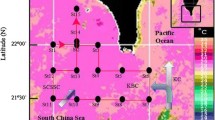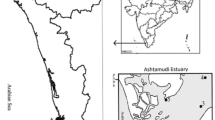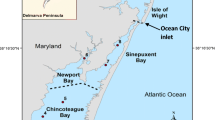Abstract
A study was made of copepods of the family Acartiidae which form the dominant component of the plankton in the Cochin Backwater (Kerala, India). At least nine species inhabit the backwater at one time or another, more than have been recorded for any other area. Reasons were sought for this diversity. The surface plankton was sampled from the head of the estuary to the mouth and from one season to another. There were large seasonal changes in salinity (0 to 35 ‰), due to monsoonal flooding, and associated changes in species composition. Species diversity was highest during the dry season and lowest in the wet. It is suggested that this annual catastrophic flooding leads, in the long run, to high species diversity by imposing a regular check on interspecific competition.
Similar content being viewed by others
Literature cited
Abraham, S.: A preliminary systematic survey of the family Acartiidae with special reference to Cochin backwaters. First All-India Symp. estuar. Biol., December 27–30, 1969, Madras (Abstracts) p. 6 (1969).
Anraku, M. and M. Omori: Preliminary survey of the relationship between the feeding habit and the structure of the mouthparts of marine copepods. Limnol. Oceanogr. 8 (1), 116–126 (1963).
Barlow, J. P.: Physical and biological processes determining the distribution of zooplankton in a tidal estuary. Biol. Bull. mar. biol. Lab., Woods Hole 109, 211–235 (1955).
Conover, R. J.: Oceanography of Long Island Sound, 1952 to 54. VI. Biology of Acartia clausi and A. tonsa. Bull. Bingham oceanogr. Coll. 15, 156–233 (1956).
—: Notes on the seasonal distribution of zooplankton in Southampton Water with special reference to the genus Acartia. Ann. Mag. nat. Hist. (12th Ser.) 10, (109), 63–67 (1959).
—: Zooplankton — life in a nutritional dilute environment. Am. Zool. 8, 107–118 (1968).
Corkett, C. J.: Techniques for breeding and rearing marine calanoid copepods. In: Cultivation of marine organisms and its importance for marine biology. Helgoländer wiss. Meeresunters. 20 318–324 (1970).
Darbyshire, M.: The surface waters off the coast of Kerala, southwest India. Deep Sea Res. 14, 295–320 (1967).
Deevey, G. B.: The zooplankton of Tisbury Great Pond. Bull. Bingham oceanogr. Coll. 12 (1), 1–44 (1948).
Elgmork, K.: Ecological aspects of diapause in copepods. Symposium on Crustacea, Vol. 3. pp 947–954. Mandapam Camp: Marine Biological Ass. of India 1967.
George, M. J.: Observations on the plankton of the Cochin backwaters. Indian J. Fish. 5, 375–401 (1958).
Hardin, G.: The competitive exclusion principle. Science, N.Y. 131, 1292–1297 (1960).
Hedgpeth, J. W.: Estuaries and Lagoons. II Biological aspects. In: Treatise on marine ecology and palcoecology. Vol. 1. Ecology, pp 693–729. Ed. by J. W. Hedgpeth. New York: Geological Society of America 67, 693–729 (1957).
Heinle, D. R.: Population dynamics of exploited cultures of calanoid copepods. In: Cultivation of marine organisms and its importance for marine biology. Helgoländer wiss. Meeresunters. 20, 360–372 (1970).
Hutchinson, G. E.: Copepodology for the ornithologist. Ecology 32 (3), 571–577 (1951).
—: The concept of pattern in ecology. Proc. Acad. nat. Sci. Philad. 105, 1–12 (1953).
Hutchinson, G. E.: Concluding remarks. In: Population studies: animal ecology and demography. Cold Spring Harb. Symp. quant. Biol. 22, 415–427 (1957).
Jeffries, H. P.: Succession of two Acartia species in estuaries. Limnol. Oceanogr. 7, 354–364 (1962).
Jeffries, H. P.: Saturation of estuarine zooplankton by con-generic associates. In: Estuaries, pp 500–508. A.A.A.S. Publ. No. 83, Washington D.C.: 1967.
Ketchum, B. H.: Relation between circulation and planktonic populations in estuaries. Ecology 35 (2), 191–200 (1954).
MacArthur, R. H.: Patterns of species diversity. Biol. Rev. 40, 510–533 (1965).
Maghraby, A. M. El: The seasonal variation in length of some marine planktonic copepods from the Eastern Mediterranean at Alexandria. Crustaceana 8, 37–47 (1964).
Malek, I. and Z. Fencl: Theoretical and methodological basis of continuous culture of microorganisms, 655 pp. New York: Academic Press 1966.
McLaben, I. A.: Effects of temperature on growth of zooplankton and the adaptive value of vertical migration. J. Fish. Res. Bd Can. 20, 685–727 (1963).
Mullin, M.: Selective feeding by calanoid copepods from the Indian Ocean. Vol. 3. pp 955–964. Mandapam Camp: Marine Biological Ass. of India 1967.
Nair, K. K. C. and D. J. Tranter: Zooplankton distribution along salinity gradients in the Cochin backwaters before and after the monsoon. First All-India Symp. estuar. Biol., December 27–30, 1969, Madras. (Abstracts) p. 21 (1969).
Nassogne, A.: Influence of food organisms on the development and culture of pelagic copepods. In: Cultivation of marine organisms and its future for marine biology. Helgoländer wiss. Meeresunters. 20, 333–345 (1970).
Petipa, T. S.: The diurnal feeding rhythm of the copepod crustacean Acartia clausi Giesbr. Dokl. Akad. Nauk SSSR (Biol. Sci. Sect.) 120, 435–437 (1958).
—: Oxygen consumption and food requirements of copepods Acartia clausi Giesbr. and A. latisetosa Kritcz. Zool J. 45, 363–370 (1966a).
Petipa, T. S.: Relationship between growth, energy metabolism, and ration in Acartia clausi Giesbr. In: Physiology of marine animals. Biologiya Morei 6, 82–91 (1966b).
Qasim, S. Z.: Some problems related to the food chain in a tropical estuary. In: Marine food chains. pp 45–51. Ed. by J. H. Steele. Edinburgh: Oliver & Boyd 1970.
— and C. V. G. Reddy: The estimation of plant pigments of Cochin backwater during the monsoon months. Bull. mar. Sci. 17 (1), 95–110 (1967).
Ramamirtham, C. P. and R. Jayaraman: Some aspects of the hydrographical conditions of the backwaters around Willingdon Island (Cochin). J. mar. biol. Ass. India 5 (2), 170–177 (1963).
Ravindranatha Menon, N., P. Venugopal and S. C. Goswami: Total biomass and faunistic composition of the zooplankton in the Cochin backwaters. First All-India Symp. estuar. Biol., December 27–30, 1969, Madras. (Abstracts) 12–13 (1969).
Sankaranarayanan, V. N. and S. Z. Qasim: Nutrients of the Cochin Backwater in relation to environmental characteristics. Mar. Biol. 2, 236–247 (1969).
Santhakumari, V. and M. Vannucci: Monsoonal fluctuations in the distribution of hydromedusae in Cochin backwaters 1968–69. First All-India Symp. Estuar. Biol., December 27–30, 1969, Madras. (Abstracts) 18–19 (1969).
Slobodkin, L. B.: Growth and regulation of animal populations, 184 pp. New York: Holt, Rinehart α Winston 1963.
Steuer, A.: Bausteine zu einer Monographie der Copepodengattung Acartia. Arb. zool. Inst. Univ. Innsbruck 1, 89–146 (1923).
Subba Raju, R. C.: Variation of developmental time of Acartia (copepoda) with latitude. Curr. Sci. 36 (1) 18–19 (1967).
Tranter, D. J.: The Australian Clarke-Bumpus sampler and calibration tank. Tech. Pap. Div. Fish. Oceanogr. C.S.I.R. O. Aust. 19, 1–16 (1966).
Tranter, D. J. A review of the natural resources of humid tropical Asia. Marine biology, Paris: Unesco (In press).
— and P. E. Smith: Zooplankton sampling. 3. Filtration performance. Monogr. Oceanogr. Methodol. 2, 27–56 (1968).
Vannucci, M., V. Santhakumari and E. P. Dos Santos: The ecology of hydromedusae from the Cochin area. Mar. Biol. 7, 49–58 (1970).
Vebvoort, W.: Copepods from Antarctic and sub-Antarctic plankton samples. Rep. B.A.N.Z. antarct. Res. Exped. (B) 3, 1–160 (1957).
Vijayalakshmi Nair, R.: Seasonal fluctuations of chaetognaths in the Cochin backwaters. First All-India Symp. Estuar. Biol., December 27–30, 1969, Madras. (Abstracts) 24–25 (1969).
Wellershaus, S.: On the taxonomy of planktonic copepoda in the Cochin backwater (a South Indian estuary). Veröff. Inst. Meeresforsch. Bremerh. 11, 245–286 (1968).
Zillioux, E. J.: A continuous re-circulating culture system for planktonic copepods. Mar. Biol. 4, 215–218 (1969).
Author information
Authors and Affiliations
Additional information
Communicated by G. F. Humphrey, Cronulla
Rights and permissions
About this article
Cite this article
Tranter, D.J., Abraham, S. Coexistence of species of Acartiidae (Copepoda) in the Cochin Backwater, a monsoonal estuarine lagoon. Mar. Biol. 11, 222–241 (1971). https://doi.org/10.1007/BF00401271
Accepted:
Issue Date:
DOI: https://doi.org/10.1007/BF00401271




